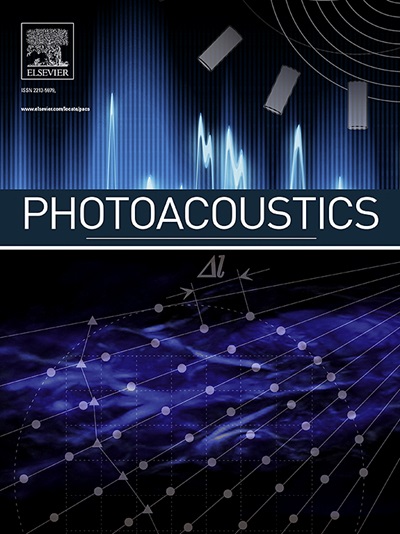光声谐振器拓扑优化方法“MMA-BP”及其在微型花瓶型光声电池pt级气体传感器中的实现
IF 6.8
1区 医学
Q1 ENGINEERING, BIOMEDICAL
引用次数: 0
摘要
提出了一种光声谐振器拓扑优化方法——Bernstein多项式移动渐近线法(MMA-BP)。该方法在一种使用微型花瓶型光声电池(V-PAC)的pt级超灵敏光声光谱气体传感器中得到了验证。V-PAC的体积仅为5 mL,对C2H2的最小检测限为281 ppt,积分时间为768 s,对应于单光路的归一化噪声当量吸收为4.46 × 10⁻9∙cm⁻1∙Hz⁻1/2。它比使用传统的t型PAC改进了大约14倍。我们通过实验研究了使用薄谐振腔管的传统PAC内部的频移,并确定了损耗对谐振频移的影响。还研究了花瓶型PAC的几何收缩效应。提出的拓扑MMA-BP方法及其实现为建立用于光声气体检测的优化PAC结构提供了一种通用方法。本文章由计算机程序翻译,如有差异,请以英文原文为准。
Topological optimization method “MMA-BP” for photoacoustic resonator and implementations in ppt-level gas sensor using miniaturized vase-type photoacoustic cells
A topological optimization method for photoacoustic resonators is proposed as the Method of Moving Asymptotes with Bernstein Polynomials (MMA-BP). This method is demonstrated in a ppt-level ultra-sensitive photoacoustic spectroscopy gas sensor using miniaturized vase-type photoacoustic cell (V-PAC). The V-PAC has a volume of merely 5 mL and achieves a minimum detection limit of 281 ppt for C2H2 with an integration time of 768 s, corresponding to a normalized noise equivalent absorption of 4.46 × 10⁻9∙cm⁻1∙Hz⁻1/2 with a single optical path. It represents an improvement of approximately 14 times beyond that of using the conventional T-type PAC. We experimentally investigated consequent frequency shifts within conventional PACs with thin resonator tubes, and determined the influence of losses on the resonant frequency shift. The geometric contraction effect in vase-type PAC is also investigated. The proposed topological MMA-BP method and implementations provide a universal approach to establish optimized PAC structures for photoacoustic gas detection.
求助全文
通过发布文献求助,成功后即可免费获取论文全文。
去求助
来源期刊

Photoacoustics
Physics and Astronomy-Atomic and Molecular Physics, and Optics
CiteScore
11.40
自引率
16.50%
发文量
96
审稿时长
53 days
期刊介绍:
The open access Photoacoustics journal (PACS) aims to publish original research and review contributions in the field of photoacoustics-optoacoustics-thermoacoustics. This field utilizes acoustical and ultrasonic phenomena excited by electromagnetic radiation for the detection, visualization, and characterization of various materials and biological tissues, including living organisms.
Recent advancements in laser technologies, ultrasound detection approaches, inverse theory, and fast reconstruction algorithms have greatly supported the rapid progress in this field. The unique contrast provided by molecular absorption in photoacoustic-optoacoustic-thermoacoustic methods has allowed for addressing unmet biological and medical needs such as pre-clinical research, clinical imaging of vasculature, tissue and disease physiology, drug efficacy, surgery guidance, and therapy monitoring.
Applications of this field encompass a wide range of medical imaging and sensing applications, including cancer, vascular diseases, brain neurophysiology, ophthalmology, and diabetes. Moreover, photoacoustics-optoacoustics-thermoacoustics is a multidisciplinary field, with contributions from chemistry and nanotechnology, where novel materials such as biodegradable nanoparticles, organic dyes, targeted agents, theranostic probes, and genetically expressed markers are being actively developed.
These advanced materials have significantly improved the signal-to-noise ratio and tissue contrast in photoacoustic methods.
 求助内容:
求助内容: 应助结果提醒方式:
应助结果提醒方式:


